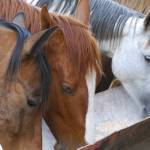Ingested Wire and Colic in Horses

Some horses have indiscriminate palates, chewing and swallowing foreign objects as readily as they would blades of grass or kernels of cereal grain. A retrospective study of horses that ingested metallic wire detailed clinical features, diagnostics, and potential treatments.*
Medical records of 16 horses that ingested a wire were mined for data and owners of these horses were contacted for further information, when possible.
Clinical signs of affected horses included colic, lethargy, and decreased appetite. Survivors had lower median white blood cell count, neutrophil count, and plasma total protein concentration, compared with nonsurvivors. The presence of wire was confirmed by abdominal radiography, exploratory abdominal surgery, or necropsy. Wire had punctured the gastrointestinal tract in 13 horses, with 10 of those developing abdominal abscesses.
Of the 16 horses in the study, four survived and were discharged from the hospital; the other 12 died. All survivors had undergone surgery.
How do you keep wire and other sharp objects out of your horse’s environment?
-
Do not use steel-belted tires as feed tubs, especially old ones that have exposed wire mesh.
-
Keep track of hypodermic, suture, and acupuncture needles as they are used, and dispose of them properly. If you’re unsure how to dispose of needles, ask your veterinarian for guidance.
-
Perform random checks of bedding, sifting it carefully from time to time, to ensure pieces of wire have not been tossed into a collection bin at the factory. Some bedding manufacturers are more careful than others about letting impurities into the final product.
-
Collect trash from paddocks and pastures adjacent to roads as frequently as possible, being sure to walk all areas that horses have access to. Pieces of wire and other debris can hide in long grass.
-
Properly dispose of baling wire as it is removed from hay. Though wire is used infrequently compared to twine, some hay producers still bind bales with it.
*Marley, L.K., C. Soffler, and E.S. Hackett. 2018. Clinical features, diagnostic methods, treatments, and outcomes associated with ingested wires in the abdomen of horses: 16 cases (2002-2013). Journal of the American Veterinary Medical Association 253:781-787.








